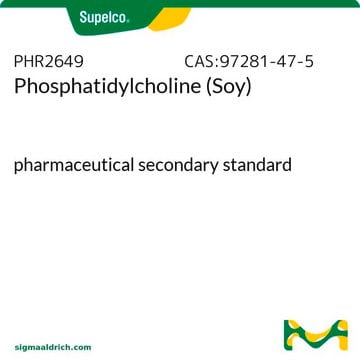SMB00611
1,2-Dilauroyl-sn-glycero-3-phosphorylglycerol sodium salt
≥98%
Sinonimo/i:
1,2-Didodecanoyl-sn-glycero-3-phosphorylglycerol sodium, 1-[[[(2,3-Dihydroxypropoxy)hydroxyphosphinyl]oxy]methyl]-1,2-ethanediyl ester-dodecanoic acid sodium
About This Item
Prodotti consigliati
Saggio
≥98%
Stato
powder
Gruppo funzionale
carboxylic acid
Tipo di lipide
phosphoglycerides
Condizioni di spedizione
wet ice
Temperatura di conservazione
−20°C
InChI
1S/C30H59O10P.Na/c1-3-5-7-9-11-13-15-17-19-21-29(33)37-25-28(26-39-41(35,36)38-24-27(32)23-31)40-30(34)22-20-18-16-14-12-10-8-6-4-2;/h27-28,31-32H,3-26H2,1-2H3,(H,35,36);/q;+1/p-1/t27-,28+;/m0./s1
CIRSYGHBBDDURM-DUZWKJOOSA-M
Azioni biochim/fisiol
Phosphatidylglycerols are used in in silico studies of model membranes. Under specific experimental conditions, they exhibit similar phase transition properties as zwitterionic phosphatidylcholines[2]. Lipid-based particle drug delivery studies using dispersions of dilauroylphosphatidylethanolamine (DLPE) and dilauroylphosphatidylglycerol (DLPG) have been shown to exhibit a metastable state which allows for the manipulation of delayed nucleation; thus providing new avenues in the design of novel modalities for the drug delivery of therapeutic payloads[3].
Codice della classe di stoccaggio
11 - Combustible Solids
Classe di pericolosità dell'acqua (WGK)
WGK 3
Punto d’infiammabilità (°F)
Not applicable
Punto d’infiammabilità (°C)
Not applicable
Scegli una delle versioni più recenti:
Certificati d'analisi (COA)
Non trovi la versione di tuo interesse?
Se hai bisogno di una versione specifica, puoi cercare il certificato tramite il numero di lotto.
Possiedi già questo prodotto?
I documenti relativi ai prodotti acquistati recentemente sono disponibili nell’Archivio dei documenti.
Filtri attivi
Il team dei nostri ricercatori vanta grande esperienza in tutte le aree della ricerca quali Life Science, scienza dei materiali, sintesi chimica, cromatografia, discipline analitiche, ecc..
Contatta l'Assistenza Tecnica.








